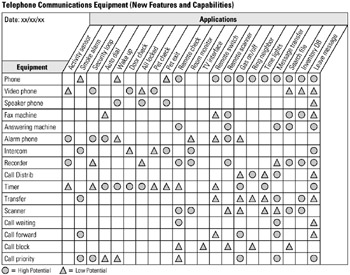Tool 27: Checkerboard Method
| AKA | Checkerboard Diagram |
| Classification | Idea Generating (IG) |
Tool description
The checkerboard method uses an interrelational matrix to plot interrelationships or the effects of various factors on one another. By combining possible concepts, features, and capabilities, powerful combinations of (or ideas for) feasible new products and services are produced.
Typical application
-
To generate ideas for new products and services.
-
To increase team creativity and innovation.
-
To discover process improvement opportunities.
-
To identify interrelationships or linkages.
Problem-solving phase
| → | Select and define problem or opportunity |
| → | Identify and analyze causes or potential change |
| Develop and plan possible solutions or change | |
| Implement and evaluate solution or change | |
| Measure and report solution or change results | |
| Recognize and reward team efforts |
Typically used by
| Research/statistics | |
| 1 | Creativity/innovation |
| 4 | Engineering |
| Project management | |
| Manufacturing | |
| 3 | Marketing/sales |
| Administration/documentation | |
| Servicing/support | |
| Customer/quality metrics | |
| 2 | Change management |
before
-
Brainstorming
-
Data Collection Strategy
-
Observation
-
Focus Group
-
Checklist
after
-
Creativity Assessment
-
Run-It-By
-
Presentation
-
Consensus Decision Making
-
Different Point of View
Notes and key points
-
Do not create matrices greater than vertical (20) horizontal (25)
-
Legend:
-
• High Potential
-
▴ Low Potential
-
□ (Blank) No Potential
-
Step-by-step procedure
-
STEP 1 Construct a matrix and determine if available factors are of sufficient detail to insert into the matrix. See example Telephone Communication Equipment.
-
STEP 2 Complete the vertical and horizontal columns as shown in the example.
-
STEP 3 Match all factors in the vertical columns with the factors in the horizontal column. Not every pairing will be applicable.
-
STEP 4 As this process of matching continues, rate potential application of feasibility by indicating • for high and ▴ for low potential.
-
STEP 5 Finally, date the completed matrix and reach consensus on the next steps.
Example of tool application

EAN: 2147483647
Pages: 326